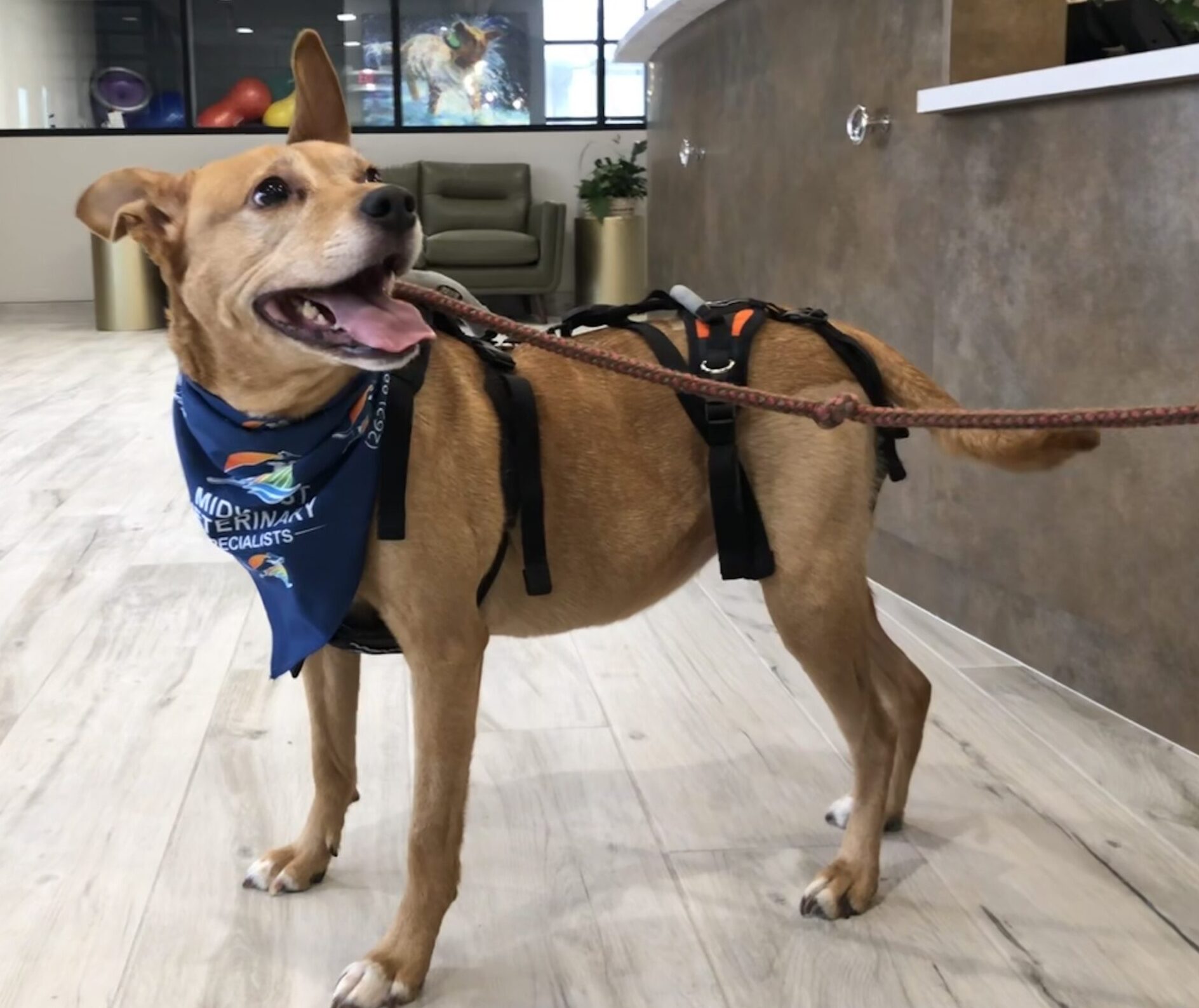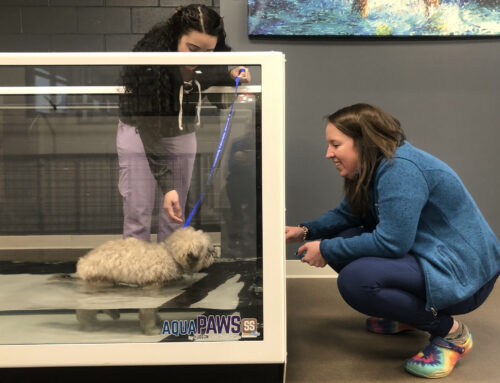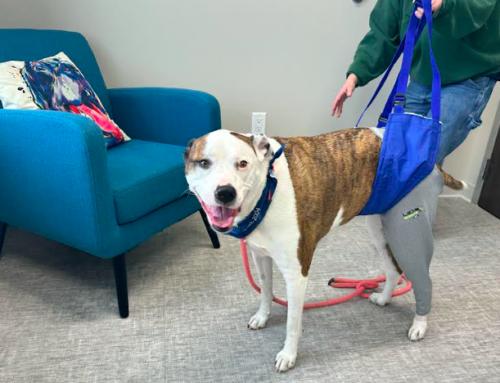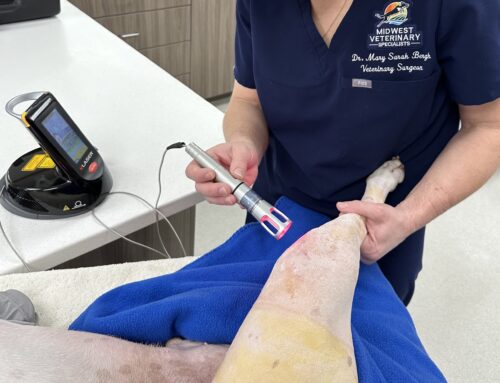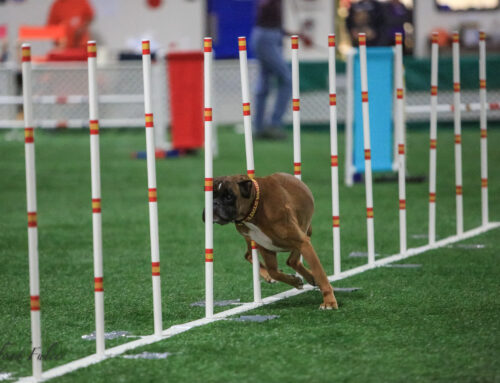Tibial plateau leveling osteotomy (TPLO) is the treatment of choice for most dogs affected by cranial cruciate ligament rupture. Proper post-operative care and rehabilitation are important after this procedure to ensure your dog returns to normal function and experiences as little pain as possible. Our Midwest Veterinary Specialists team wants to help by explaining common guidelines for post-operative care and rehabilitation following TPLO.
Confining your dog after surgery
Following surgery, you must restrict your dog’s activity to allow surgery site healing. The tibia bone will take at least eight weeks to heal, and any running, jumping, or high impact activity can disrupt this healing process. Prepare for your dog’s confinement with these tips:
- Designate an appropriate area — A small room (i.e., approximately 6×6 feet) should sufficiently limit your medium- or large-breed dog’s movement or a dog crate is ideal. Moveable pens or baby gates can also be used to create a safe and confined space for your pet during recovery.
- Prepare clean bedding — Ensure your dog has a comfortable resting place during their recovery, and change out the bedding frequently to help prevent skin irritation and incision site infection.
- Provide non-slip flooring — Hardwood, vinyl, and linoleum flooring can be dangerous postoperatively, as dogs may slip and fall. Non-slip mats can help prevent accidents in the confined space and also on the route to go outside.
- Adjust food intake — Your dog’s food intake should be reduced to account for their decreased activity and prevent weight gain.
- Prevent licking at the incision – An Elizabethan collar (E-collar) or LickSleeve should be used to prevent your pet from traumatizing the incision and introducing bacteria to the surgical site for the first two weeks post-op.
Managing your dog’s pain and mobility after surgery
For the first two weeks after TPLO surgery, the main rehabilitation goals are to decrease pain and maintain range of motion in your dog’s stifle joint. Therapies include:
- Cold packs — For the first five days after surgery, we will advise you to apply cold packs to your dog’s surgery site for 10 to 15 minutes several times a day.
- Passive range of motion (PROM) — Either standing or with your dog lying on their side with their surgical limb up, you will gently flex and extend the affected limb to help maintain range of motion.
- Warm packs — After the first five days, you can use warm packs prior to PROM exercises, to relax the tissues and increase blood flow.
- Controlled leash walks — When walking outside for bathroom breaks, slow leash walks are encouraged so that your pet uses the operated limb with each step. This will help build muscle and improve joint and bone healing. A sling or Help-em-Up harness should be used for support and to prevent slipping and falling accidents.
- Pain medication — Your dog will likely be sent home on several different pain medications—usually a non-steroidal anti-inflammatory drug (NSAID) and gabapentin—that should be administered for pain management according to the labeled recommendations.
Restoring your dog’s strength after surgery
Muscle atrophy is often present prior to surgery and can be exacerbated by decreased limb use in the recovery period. Some activities performed at home such as leash walking, weight shifting, and sit-to-stand exercises can build strength and confidence in the surgical leg. Formal rehabilitation therapy can also be added in the recovery plan to maximize the speed and extent of the recovery process. At Midwest Veterinary Specialists, we have a fully equipped, state-of-the art rehabilitation center to help with recovery after TPLO surgery! Rehabilitation therapies we commonly use include:
- Underwater treadmill — Water’s buoyancy supports your dog so they can exercise without putting excess pressure on their affected limb. Session time and treadmill speed are incrementally increased at each session.
- Therapeutic exercises — These exercises encourage muscle contraction in the affected hind limb and help improve your dog’s balance and proprioception (i.e., knowing where one’s limbs are and how they are positioned). Examples include moving from sitting to standing, walking over poles, walking backward, using physioballs, and balancing on a wobble board.
- Laser therapy — Class 4 (i.e., low level) laser therapy may be recommended to decrease pain and inflammation and improve wound healing.
- Shock wave therapy — Shock wave therapy has been shown to speed bone healing and increase comfort and limb use after TPLO surgery.
Strengthening your dog’s core muscles after surgery

As the healing process progresses, your dog will develop sufficient limb strength to support more strenuous exercises. The recovery phase is more demanding and includes exercises that help strengthen your dog’s core muscles and cardiovascular strength, including:
- Underwater treadmill — Underwater treadmill sessions use increased speed and incline to encourage increased stifle and hip action.
- Land treadmill — Land treadmill sessions can improve your dog’s gait, muscle mass, and strength.
- Swimming — Swimming can promote joint range of motion and improve cardiovascular strength.
- Core-strengthening exercises — The core muscles serve as a foundation for the hind limbs, and strengthening these muscles helps prevent injury. Therapeutic exercises, such as dancing and balancing on air-filled devices, help stimulate the core muscles.
- Adjunct therapies — Therapies such as shock wave, laser, and ultrasound may be recommended.
Minimizing your dog’s arthritis after surgery
CCL rupture in dogs is usually a degenerative process that is associated with arthritis. Taking steps to maximize your dog’s joint health can increase their odds for a successful long-term outcome. Therapies include:
- Weight management — Excess weight places unnecessary stress on your dog’s joints, and the fat cells produce chronic, low-grade inflammation that contributes to joint inflammation throughout the body. Calculate your dog’s daily energy requirements and feed them appropriate portions to ensure they remain at a healthy weight. If your dog is overweight, we will devise a weight loss program to help them safely lose the extra pounds.
- Exercise — Regular, controlled physical activity is important to keep your dog’s muscles and joints strong. Avoid excessive, high-impact activities to help prevent injury.
- Joint supplements — Dietary supplements, such as omega-3 fatty acids and polysulfated glycosaminoglycans, may minimize progressive joint cartilage degeneration.
If your dog has cranial cruciate ligament disease, a TPLO can help return them to their normal activity level. Knowing how to properly care for your dog following their procedure will help ensure they recover quickly. If your dog needs a TPLO, contact our Midwest Veterinary Specialists team, so we can get them up and running again as soon as possible.


